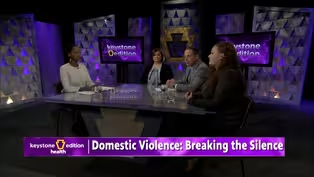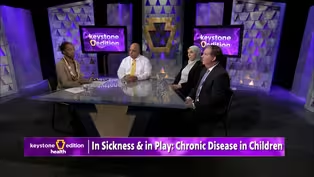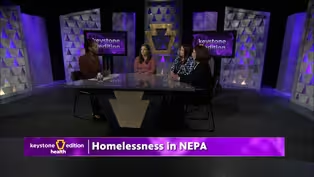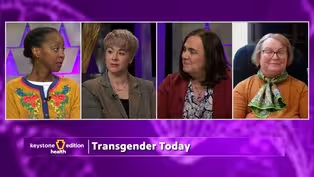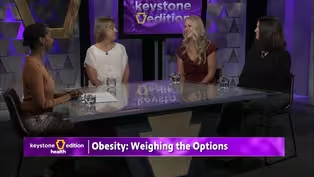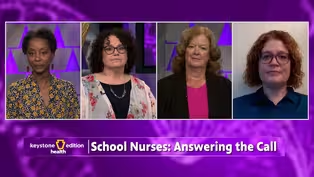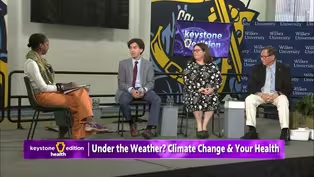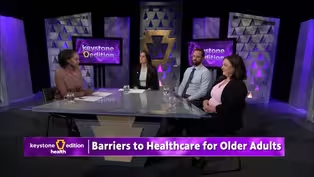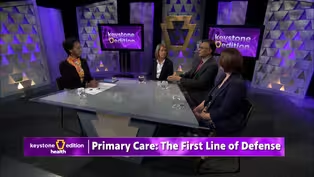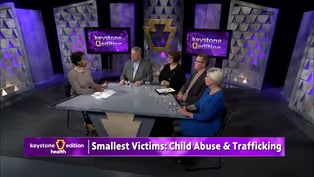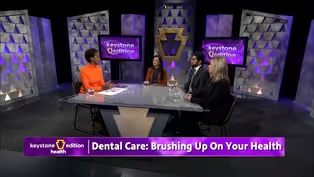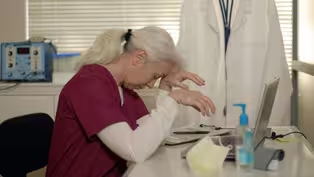Keystone Edition
Staffing Strains
10/24/2022 | 27mVideo has Closed Captions
Low staffing levels can lead to burnout among healthcare workers
The American Hospital Association has described the current shortage of healthcare workers as a critical situation. Low staffing levels can lead to burnout among healthcare workers and impact the quality of patient care. Find out how staffing shortages have impacted our area and what can be done to help.
Problems playing video? | Closed Captioning Feedback
Problems playing video? | Closed Captioning Feedback
Keystone Edition is a local public television program presented by WVIA
Keystone Edition
Staffing Strains
10/24/2022 | 27mVideo has Closed Captions
The American Hospital Association has described the current shortage of healthcare workers as a critical situation. Low staffing levels can lead to burnout among healthcare workers and impact the quality of patient care. Find out how staffing shortages have impacted our area and what can be done to help.
Problems playing video? | Closed Captioning Feedback
How to Watch Keystone Edition
Keystone Edition is available to stream on pbs.org and the free PBS App, available on iPhone, Apple TV, Android TV, Android smartphones, Amazon Fire TV, Amazon Fire Tablet, Roku, Samsung Smart TV, and Vizio.
Providing Support for PBS.org
Learn Moreabout PBS online sponsorshipMore from This Collection
Healthcare is constantly changing as technology finds new and better ways to help people live longer, healthier lives. Host Tonyehn Verkitus will address the issues that are important to the people in our community, including the ongoing pandemic, concerns about vaccines, food deserts, childhood trauma and child abuse, mental health, environmental issues, and the rising cost of staying healthy wit
Domestic Violence: Breaking the Silence
Video has Closed Captions
Access to the right resources can make facing this challenge a little easier for families (26m 59s)
In Sickness and in Play: Chronic Disease in Children
Video has Closed Captions
About 25% of children in the US aged 2 to 8 years have a chronic health condition (27m)
Video has Closed Captions
Homelessness can happen to anyone at any age or socio-economic status. (26m 59s)
Video has Closed Captions
As we raise the visibility on Transgender young adults and embrace them within our culture (26m 59s)
Video has Closed Captions
Obesity is a serious risk factor many try to avoid when developing healthy eating habits. (27m)
School Nurses: Answering the Call
Video has Closed Captions
What can our school districts do to help retain and recruit nurses for future generations? (27m)
Under the Weather? Climate Change & Your Health
Video has Closed Captions
How does climate change impact individual and public health? (54m 59s)
Barriers to Healthcare of Older Adults
Video has Closed Captions
What progress have local organizations made in addressing these challenges? (27m)
Primary Care: The First Line of Defense
Video has Closed Captions
When was the last time you saw your primary care doctor? (27m)
The Smallest Victims: Child Abuse & Trafficking
Video has Closed Captions
What are the signs to know to spot child abuse and even possible trafficking? (27m)
Dental Care: Brushing Up on Your Health
Video has Closed Captions
How can providers make dental care more affordable and accessible? (26m 59s)
Video has Closed Captions
What does the cannabis industry mean for Northeastern and Central Pennsylvania? (26m 59s)
Providing Support for PBS.org
Learn Moreabout PBS online sponsorshipLive from your public media studios wrva presents Keystone addition health a public affairs program that goes beyond the headlines to address issues and north eastern and Central Pennsylvania This is Keystone addition health and now moderator tanya Verkitus Good evening and welcome to Keystone Edition health anthony Vertitus Thank you for joining us tonight we'll look at the strains on health care staff and what administrators and educators can do to recruit and retain staff in the health care field First let's hear from wdia is paula czar the implications of the Covid-19 pandemic exposed and deepened issues and almost every industry but perhaps none more so than the health care industry as hospitals and facilities were strained more and more health care workers like nurses doctors and support staff across all specialties struggled with stress burnout and understaffing the american hospital association has described staffing shortages in the health care field as a critical problem in 20 21 they reported hospital employment decreased by 94000 since february of 2020 and by eight thousand between august and september 2021 alone as health care facilities recover from the worst days of the pandemic their existing staff who require additional support while their employers work to recruit and retain new staff for Keystone Edition health I'm Paul mazar joining us tonight we have Dr julie by early president and dean of guys and girls commonwealth school of medicine rachel's smith vice president of people in culture at evangelical community hospital is here with us as well And finally we have Dr leighton yuhi associate dean for behavioral health integration and community care transformation at the geisinger commonwealth school of medicine So thank you all for being here I think this is is gonna be a really good conversation seeing as how we've all just come out of this pandemic we're thinking a lot about health care and health care providers rachel I'd actually like to ask you Right now what types of gaps are using at the health system and approximately how many employees Do you have So we have just under two thousand employees and we really have gaps across the spectrum are constantly recruiting for all types of positions clinical positions particularly Of course nursing comes to mind but we're also seeing those gaps in other clinical areas respiratory therapist therapy medical lab science but also in support positions nursing assistance unit assistance medical assistance all of this positions in addition to environmental services nutritional services It's really across the board and I think that's important to recognize that when we talk about health care workforce We're talking about a a broad spectrum not just limiting it to one type of role within the hospital and I think we're probably always thinking about the health care providers when we look at a hospital but there's all those other people that keep the day to day operations going Absolutely Julie at the school What does your enrollment look like like do you feel like you're having less people enrolling in medical school or is it about the same Fortunately it's still very popular for young people to apply to medical school but I certainly agree with what rachel said that we need to encourage young people to apply and work and all facets of health care but last year for geisinger commonwealth school of medicine we had nearly 6000 applicants to fill our hundred fifteen slots That's a lot of applicant yes What about against of course gauzy applicant tends to apply to many schools but thankfully people still want to be doctors and nurses leighton do you think that this strain We're seeing in the workforce is unique to health care Well of course or shortages and a lot of areas in our in our culture but we've been through an unprecedented period of time with covered and the frontline workers in particular have been stress They have ptsd 30 percent of the workforce in health care has considered stopping what they're doing Not being in health care any longer Sixty percent of the established workforce feels as if their mental health has been affected adversely because of covered and then regardless of your political persuasion the country's and really in very dire straits and that takes a toll as well on what people think how they're feeling in what they're doing So you know it's projected by 2020 sex they're going to be over three million people missing from health care shortage So this is a serious problem and it requires kind of thinking in a different way about what are the solutions to try to fill this gap because it's a serious gap yeah some numbers I saw from the association of american medical colleges a report from twenty twenty one said that by 2030 for we're looking at thirty seven thousand one hundred and twenty four thousand positions that will need to beat failed and that's kind of frightening to say the least I mean we have this aging population People will require lots of health care There's all sorts of issues cropping up How do we meet that gap I'd like to know rachel We talked a little bit about covered What sort of vulnerabilities Do you think copied highlighted at the health system Well I think think that even before covered we knew that some of these shortages would be coming And I think what ended up happening is individuals suddenly re-evaluated everything about their lives which included what they wanted to do Do they want to stay in health care Where are they putting off retirement and decided now's the time so maybe rather than working five more years they did they decided they were done I think it really just took what already was a precarious situation and just exacerbated that the point of pete employees are demanding more you know and they have choice the economy is providing lots of choices for people So it's an opportune time to look around and say if I want to stay in health care where can I find the most flexible opportunity What can Where can I find my passion and for a lot of people covered made them rethink what their passion was really about do you think that you had a lot of people that were tired earlier than maybe they would have because of it I think that we definitely had people retire earlier than expected I think we also had parents who had to make hard choices about how to balance work along with that the child care needs I mean child care carries a huge issue right now A week doesn't go by that I have an employee reaching out stressed about how they're going to find child care and what that will mean with their schedule if they're able to accept a position if they can keep a position so all of those things have just really complicated The matters as well Julie there is an aging population and epa as well So how do you feel that will contribute to the strain that were already feel well we need to recruit and educate young people to come into our area to stay in our area if they're from here and then to work in and health care where they provide for the ageing population in this region we're working very hard to do that at the medical school by trying to attract students from the area to be our applicants that we accept into medical training and we're trying to incentivize them staying here because we need them I know there's also a strain on the number of behavioral health professionals that exist in the area at least this is something I hear a lot What do you think is contributing to that and how can we potentially improved that Well I think things are changing in a global sense about the attraction people going into behavioral health areas psychiatrists psychologists counselors and so forth but there is a shortage here within NorthEastern Pennsylvania and that's going to be corrected through initiatives such as geisinger has done with the guys legal scholars program dr borrowed we can talk about that a little bit bit more in terms of attracting people who are interested in primary care and in behavioral health psychiatry to stay here and come back and work in the field in those areas areas I think the connection between the science of psychiatry with clinical work in psychiatry is one of the things that is happening over the last couple of decades and that's attracting bright neuroscience graduates from colleges to go into the field because they can see that they can connect the dots between what they've learned in college and what they can apply in their clinical work and that that's going to be a big incentive for people who are you gonna tell us a little bit about that Abigail abigail guys anger scholars program Well thank you for the opportunity yes so we recognized like rachel mentioned the need to recruit people to work in our area and so guy singers investing in that recruitment upfront by funding the education of future primary care dogs and future psychiatrist who commit to serving in our region working four guys singer It's a really transformative program in that forty five future doctors each year are on full scholarship as long as they make a commitment year four year scholarship year to year of service to work for a guy singer in our region and as leighton mentioned that's in primary care for adults like family medicine or internal medicine or medicine and pediatrics with a promise to care for adults of course and then also in psychiatry and that will help us to graduate future doctors who will be committed to the area but medical education takes a long time And so it will take years before we see the payoffs of all those efforts and how many have gotten through the program Well right now we have over one hundred enrolled but I want to give great kudos to the community members in NorthEastern in Central Pennsylvania who saw this anticipated need for more doctors and founded what was then named the commonwealth medical college because we over the last decade have graduated eight hundred fifty three doctors forty seven of of whom are psychiatrist and so to graduate that many doctors many of whom will choose to stay in our area after they finish their training That was important foresight that they had then that will bolster our community but there's so much more that we need to do I'd be curious to know an evangelical do you see a lot of people coming back to the area or most of your staff local So the majority of our staff our local You know they're part of the community they want to care for the community that they've been part of but we are starting to see other people you know relocate to the area also individuals who have left for a while and decided that it's time to come home and be part of that so we're always you know we have great partnerships with many of the local colleges and universities we provide opportunity for students to do clinical rotations and we are always are telling those students you know Think of evangelical but maybe now is not the time if if if it is great If not think of us in the future when you maybe want to come back to the area so just keeping that pipeline open and really having students floor I think that was one thing that during covered a lot of students didn't have the same opportunities to engage in the clinical experiences and so as we have in engaged with this With the colleges and universities it's important to get students back at the bedside so they really understand you know whether this is a good fit for them they they feel more confident in their clinical skills that they're learning in the classroom and just the relationships that they're able to build and more importantly to see how health care works together it truly is teamwork and so just being able to be there and look around and see who are all the players wearing different colors different roles and how they all contribute to the care of the patient and ultimately the care of our community Yes that's the message I would like for the young people of our area to to know is that working in health care there's so much variety of what you could choose to do but it's all of us are blending science and service as we work in health care together and there are many ways that you could dig deep into the science and make discoveries that improve health and well-being deep deep deep deep into the service and do lots of hands on work like nurses do but I really do hope that young people in our area will consider that for their future career because there's just so much in the ways that you can make a difference You've talked about community and part of your title is community care We spoke a little about a real resilience program that you're working on with other colleges and universities Can you tell us a little bit about well if it gets to the point about how health here in my opinion needs to shift so in health care We're looking for pathology but there are other aspects that are important so looking for resilience kind of what makes a person's stronger in the face of adversity is an important aspect that health care can come into an occupy we have a project underway that at this point in time involves 13 including the medical school twelve colleges universities in this area around the concept of resilience can those institutions come together and collectivize around developing a curriculum on resilience science which may be a new focus for the 21st century and all the aspects of that means ranging from the neuroscience aspects the psycho social aspects of resilience What is it that protects people from adversity and it gets into other other things such as architecture and things like that We have a colloquium coming up in april Twenty twenty three We're we're bringing in some major figures in in the resilience world to address that here in this community and the question is can nepa become a community of resilience in the broad spectrum spectrum that i'm talking about It's not that we understand that people from this area are tough and and hardscrabble that as the word that's been used to describe the population here That's not what this is about those that's resilience in another form This is about how do we a 21st century community of resilience which gets into individual community and the civil engineering of resilience what you communities need to look like to become commuted communities of resilience rockefeller foundation has identified communities of resilience urban urban institute has identified attributes of resilience so there's a lot of stuff that goes into this and so the question is can these colleges and universities along with the medical school come together and form a curriculum begin to connect the neuroscience of resilience with the psycho social aspects of resilience that's that's what this is all about Can't wait to see how that plays out And when you talk about resilience I can't help but think about well being what types of things Are you are each working on in terms of while being from the student level to the professional level right Our workforce needs to be sustainable and working in health care is extremely challenging It's been especially challenged through the pandemic and some of the erosion in the trust and in the way that we treat each other Has made it even more difficult to work in the clinical environment and so what we're trying to do early on for our workforce is instill in them sustained optimism through their own wellness we're trying to make the work environments respectful We're trying to ensure that people have opportunities for the basic needs like Time to eat and time to rest in time to exercise Time to breathe outside air and time to relate with each other on on their team and build relationships We also are providing mental health services for the care providers we have two full time counselors at the medical schools serving our students and hopefully helping them to develop strategies that will maintain their well-being throughout their long and productive careers and even before the pandemic I mean we recognize the importance of well-being and really looking at multiple dimensions of that So certainly the physical well-being but the emotional the mental health peace but also the financial well-being You know we have individuals in all kinds of situations and so that stability and understanding You know how to manage through any circumstance but also the social well-being and I think that's something that during cove it became very apparent that employees were missing because in many ways behind masks limited physical movement through a facility They're just weren't those opportunities for staff to connect in the ways that they had before And so we continue to build on programs that really look at all of those dimensions and I really helped us reconnect people to their teams to the mission of the organization Over Over half of our workforce now has been with the organization less than five years and we had quite a few employees who are actually hired during the pandemic and we say we've never actually seen them without a mask and so just helping people reestablish those trusting relationships throughout the pandemic we increase our reliance on travelers are agency staff as well and those were individuals who are coming to us from across the country Very well skilled in their areas but it all comes down to that delicate balance of relationship and people knowing I can trust you I know you We have each other's backs We know how to communicate with one another and there's been a lot of that That's been disrupted and weighs in a very positive way It's brought in a lot of new ideas and perspectives into the workplace but it's also for some people uncomfortable because what the organization look like pre pandemic It will never really look exactly that way again and so helping build that resilience to be able to manage through all the change not only brought about by the pandemic but just Health care is constantly changing I'm late I know that oftentimes people who are caregivers aren't that likely to take care of themselves so how do we convince these health care professionals that maybe they should seek care for themselves Well I think that gets back to the The impact of covered and i've seen a number of of the workforce in my clinical work and what I see there is that people coming forward recognizing that they need help and that is a different scenario these days it's more common scenario The other thing that I think about is that the commonwealth fund has identified that only 20 percent of health is determined by health care The rest is determined by individual preferences such as you know tobacco use alcohol and drugs diet and exercise things like that and then other factors such as as occupation community safety things of that nature and then areas such as water quality air quality environmental issues all of those are factors that have been outside of health care to some extent and maybe it's time to begin to think about how do you fold that into the health care system in order to address that with people who are coming for help in health care I want to go back to what you said about the environment never quite being the same again after a bit How do you create a culture that sustains itself even through a pandemic so I think we talk about culture a lot and certainly employees are looking for a culture Right They stay for a culture they contribute to the culture and so I believe that elements of our culture that were in place prior to the pandemic still exist but the way in which we work the impact that cove it had on our community and on our caregivers themselves That won't That won't be able to be erased right that we carry forward and and so part of that is by building a sense of engagement providing opportunities for employees to contribute ideas to get feedback to be recognized at all levels of the organization and just constantly be listening to what employees are saying and recognizing that you know as employees change their expectations may change but it goes back to creating that safe respectful work environment where individuals feel like they can contribute they can connect to the mission that they feel valued for the work that they're doing and that takes work building and maintaining a culture and we talk a lot about needing to restabilize a little bit after such a disruptive couple of years and trying to get back to some of those things that are really important Our community relies on us to care for them and so we want to make sure that all of our caregivers feel supported every every day when they come to work and that's the place a place where the public can help us Everyone goes into health care because they care about one another Every single applicant to medical school has to demonstrate compassion to be successful upon entry nurses by definition shin need to be compassionate to want to do the work that they do and you bring this compassion to work and you serve it up to the public What the public can do in response and respectful engagement in that simple Thank you Ads tremendous value to end tremendous meaning to the sustainability of our work for so I would just pick up on what rachel said to within the organizations in which we work we try to build culture and community but the public adds to that as well give back Thank you Now julie i'm going to call you out a little bit here I know you're new to the area so when we think about how we're enticing people to come to scranton or you know luzerne county What would you you say you would highlight because I know people here may not think they have something to highlight for an outsider but as an outsider what should we be about our communities Well I am new to the area i'm sure you can hear in my voice that my southern roots Hi came here in january and my husband and I have come to love the area we are so enjoying the nature the opportunities to hike the beautiful autumn My goodness it's just striking and many recreational activities that are available in this incredibly beautiful natural setting We also have been embraced kind people and I think there is a humility here to the culture that we should examine a little bit and and recruit others to join us in this region with some pride There's a lot to be excited about here and I loved it For us to all began talking more about it as we try to recruit young work force to help us care for aging population maybe that can be part of this resilience program to highlight what we do here have in the area that actually add to our resilient Well I think Dr borrowing is a pediatrician and so she would agree with me that beginning early with kids sort of in the resilience project head start early head start is certainly a target population to begin early talking about the attributes thought resilience and resilience enhancement which we think it can occur but we're interested across the age range But still it is instilling resilience into a variety of different populations but I think you would agree that starting early makes a lot of sense I do think that we could go on forever with this conversation I've definitely enjoyed it I want to say thank you to all of our gas for joining us And thank you for watching i'm Tonyehn Vertitus Have a good evening
Preview: 10/24/2022 | 30s | Airs Monday, October 24th at 7pm on WVIA TV (30s)
Providing Support for PBS.org
Learn Moreabout PBS online sponsorship
- News and Public Affairs

Top journalists deliver compelling original analysis of the hour's headlines.

- News and Public Affairs

FRONTLINE is investigative journalism that questions, explains and changes our world.












Support for PBS provided by:
Keystone Edition is a local public television program presented by WVIA
